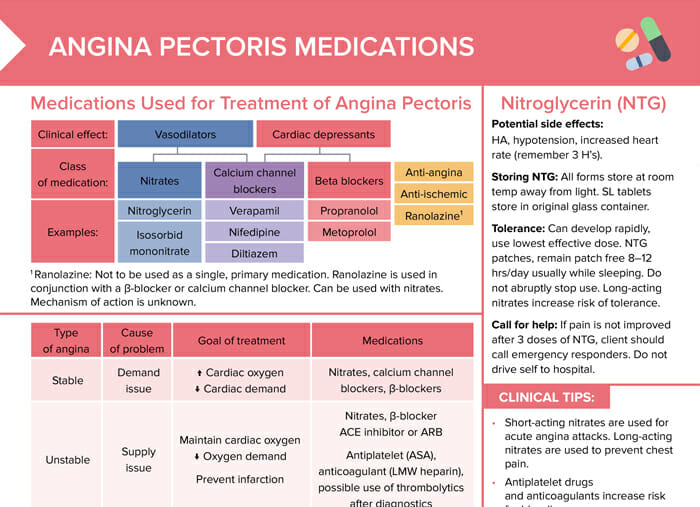Nursing Knowledge
Angina pectoris ( “angina”, acute chest pain or discomfort) occurs when the heart doesn’t receive enough blood.
The ICD-10 code for angina pectoris is I20.
Decreased blood flow leads to decreased oxygen to the myocardium, causing pain. The cause of decreased blood flow varies in each type of angina pectoris.
| Type | Cause | Characteristics |
| Stable | Fixed stenosis (demand ischemia) | Triggered by exertion, stress, cold exposure, coronary artery disease Relieved by rest or medication Predictable and consistent |
| Unstable | Thrombus (supply ischemia) | May occur at rest or with exertion Worsens over time May not be relieved by rest or medication Lasts longer than 20 minutes, may go away and come back |
| Variant Prinzmetal | Vasospasm (supply ischemia) | Occurs most commonly at night, during rest/sleep Relieved by medication |
In women, angina symptoms may be more subtle and overlooked, causing a delay in care. In addition to traditional chest pain, women are more likely to experience these symptoms:
Understanding ECG changes associated with angina pectoris is essential for nurses to recognize, such as:
Possible ECG changes due to angina pectoris:
Note: EKG may be normal in clients with angina pectoris, especially when currently no symptoms are experienced.
If O2 SAT < 90% or in respiratory distress:

Review of medications used for acute and stable angina
| Type | Goal of treatment | Medications |
| Stable | Increase cardiac oxygen, decrease cardiac demand | Nitrates, calcium channel blockers, β-blockers |
| Unstable | Maintain cardiac oxygen, decrease oxygen demand, prevent infarction | Nitrates, β-blocker, CE inhibitor or ARB, antiplatelet (ASA), anticoagulant (LMW heparin), possible use of thrombolytics after diagnostics |
| Variant Prinzmetal | Increase cardiac oxygen | Nitrates, calcium channel blockers |
RELATED TOPIC:
Free Download
Master the topic with a unique study combination of a concise summary paired with video lectures.
USMLE™ is a joint program of the Federation of State Medical Boards (FSMB®) and National Board of Medical Examiners (NBME®). MCAT is a registered trademark of the Association of American Medical Colleges (AAMC). NCLEX®, NCLEX-RN®, and NCLEX-PN® are registered trademarks of the National Council of State Boards of Nursing, Inc (NCSBN®). None of the trademark holders are endorsed by nor affiliated with Lecturio.
Your free account gives you access to:
or
Have a holly, jolly study session 🎁 Save 50% on all plans now >>